Toyota 4Runner: If your vehicle needs to be towed
If towing is necessary, we recommend having your vehicle towed by your Toyota dealer or a commercial towing service, using a lift-type truck or flatbed truck.
Use a safety chain system for all towing, and abide by all state/provincial and local laws.
Before towing
The following may indicate a problem with your transmission. Contact your Toyota dealer before towing.
• The engine is running but the vehicle will not move.
• The vehicle makes an abnormal sound.
Emergency towing
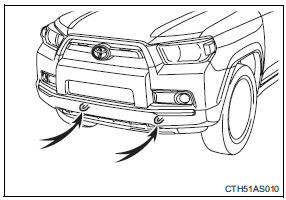
If a tow truck is not available in an emergency, your vehicle may be temporarily towed using a cable or chain secured to the emergency towing eyelet(s).
This should only be attempted on hard surfaced roads for short distances at low speeds.
A driver must be in the vehicle to steer and operate the brakes.
The vehicle’s wheels, drive train, axles, steering and brakes must be in good condition.

Vehicles with a front spoiler only: Before using the front emergency towing eyelet(s), remove the cover(s).
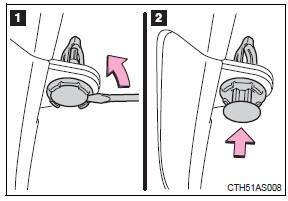
1. Removing the clips
2. Installing the clips
Towing with a sling-type truck
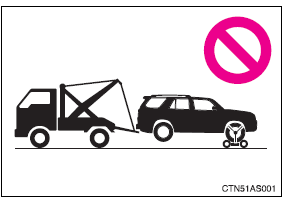
Do not tow with a sling-type truck to prevent body damage.
Towing with a wheel lift-type truck
From the front

Use a towing dolly under the rear wheels.
From the rear (2WD models)

Vehicles without a smart key system: Turn the engine switch to the “ACC” position so that the steering wheel is unlocked.
Vehicles with a smart key system: Turn the “ENGINE START STOP” switch to ACCESSORY mode so that the steering wheel is unlocked.
From the rear (4WD models)
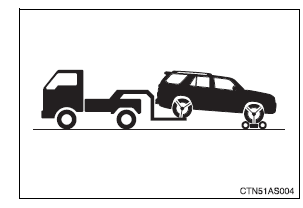
Full-time 4WD models: Use a towing dolly under the front wheels.
Part-time 4WD models: When not using a towing dolly, turn the engine switch to the “ACC” position, shift the shift lever to N and shift the front-wheel drive control lever or switch to H2.
Using a flatbed truck
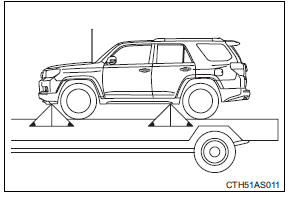
If you use chains or cables to tie down your vehicle, the angles shaded in black must be 45°.
Do not overly tighten the tie downs or the vehicle may be damaged.
Before emergency towing
 Vehicles without a smart key
Vehicles without a smart key
system: Turn the engine switch to the “ACC” (engine off) or “ON” position.
Vehicles with a smart key system: Turn the “ENGINE START STOP” switch to ACCESSORY (engine off) or IGNITION ON mode (engine running).
 Part-time 4WD models:
Part-time 4WD models:
Type A
Shift the front-wheel drive control lever to H2.
Type B
Put the front-wheel drive control switch to H2.
Full-time 4WD models: Put the four-wheel drive control switch in H4F. (The center differential is unlocked.)
 Shift the shift lever to N.
Shift the shift lever to N.
 Release the parking brake.
Release the parking brake.
CAUTION
Caution while towing
• Use extreme caution when towing the vehicle.
Avoid sudden starts or erratic driving maneuvers which place excessive stress on the emergency towing eyelets and the cables or chains. Always be cautious of the surroundings and other vehicles while towing.
• Vehicles with a smart key system: Do not turn the “ENGINE START STOP” switch off.
Doing so will lock the steering wheel and prevent operation, possibly causing an accident and resulting in death or serious injury.
• If the engine is not running, the power assist for the brakes and steering will not function, making steering and braking more difficult.
NOTICE
To prevent causing serious damage to the transmission and transfer (4WD models) when towing using a wheel-lift type truck
2WD models: Never tow this vehicle from the front with the rear wheels on the ground.
4WD models: Never tow this vehicle with any of the wheels in contact with the ground.
To prevent damage to the vehicle when towing using a wheel-lift type truck
• 2WD models without a smart key system: Do not tow the vehicle from the rear when the engine switch is in the “LOCK” position or the key is removed. The steering lock mechanism is not strong enough to hold the front wheels straight.
• 2WD models with a smart key system: Do not tow the vehicle from the rear when the “ENGINE START STOP” switch is off. The steering lock mechanism is not strong enough to hold the front wheels straight.
• When raising the vehicle, ensure adequate ground clearance for towing at the opposite end of the raised vehicle. Without adequate clearance, the vehicle could be damaged while being towed.
NOTICE
To prevent body damage when towing with a sling-type truck
Do not tow with a sling-type truck, either from the front or rear.
To prevent causing serious damage to the transmission and transfer (4WD models) in emergency towing
Never tow a vehicle from the rear with four wheels on the ground. This may cause serious damage to the transmission and transfer.
 Emergency flashers
Emergency flashers
Use the emergency flashers if the vehicle malfunctions or is involved in
an accident.
Press the switch to flash all the turn signal lights. To turn them off,
press the switch once again.
NOTIC ...
 If you think something is wrong
If you think something is wrong
If you notice any of the following symptoms, your vehicle probably needs
adjustment or repair. Contact your Toyota dealer as soon as possible.
Visible symptoms
• Fluid leaks under the vehicle ( ...
Other materials about Toyota 4Runner:
Removal
REMOVAL
CAUTION / NOTICE / HINT
HINT:
Use the same procedure for both the RH and LH sides.
The procedure listed below is for the LH side.
PROCEDURE
1. REMOVE FRONT DOOR LOWER FRAME BRACKET GARNISH LH
2. REMOVE NO. 2 DOOR INSIDE HANDL ...
Installation
INSTALLATION
CAUTION / NOTICE / HINT
HINT:
Use the same procedure for the RH and LH sides.
The procedure listed below is for the LH side.
When installing the window frame moulding, black out tape and outside
stripe, heat the vehicle body ...
0.007
